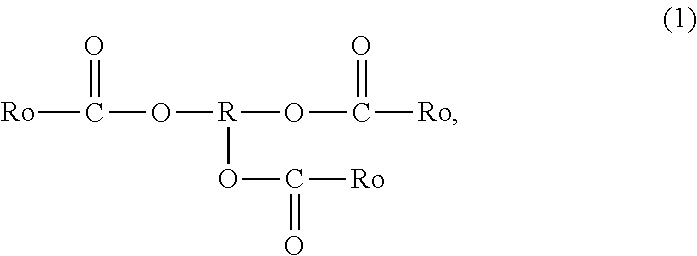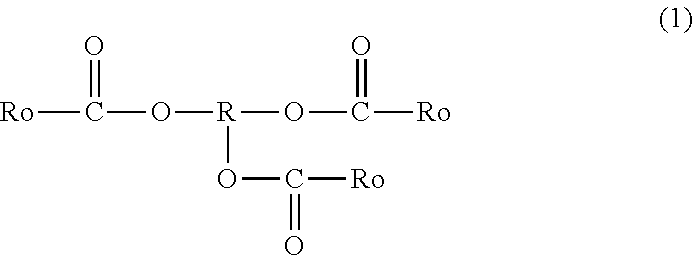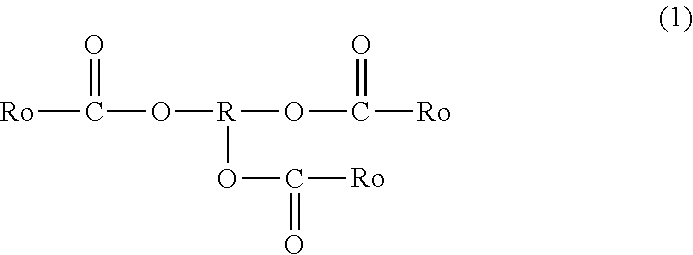Tackifier, Tackifier for Medical or Industrial Use, Adhesive and/or Pressure-Sensitive Adhesive for Medical or Industrial Use, Adhesive Sheet and/or Pressure-Sensitive Adhesive Sheet for Medical or Industrial Use, and Pressure-Sensitive Adhesive Tape for Medical or Industrial Use
a technology for tackifiers and tacks, applied in the direction of adhesive types, other rubber adhesives, bandages, etc., can solve the problems of difficult coating with an applicator, difficult to use hot melt types for coating, and the effective ingredients such as a tackifying resin blended therein may deteriorate or decompose under heat, so as to improve the coatability reduce the viscosity of synthetic rubber elastomers
- Summary
- Abstract
- Description
- Claims
- Application Information
AI Technical Summary
Benefits of technology
Problems solved by technology
Method used
Image
Examples
production example 1
Production of Dehydroabietic Acid
[0054]A commercially available disproportionated rosin (acid value: 167 mg KOH / g, softening point: 77° C. (Arakawa Chemical Industries, Ltd.)) was melt in argon flow and heated under reduced pressure of 1.3 kPa to provide a fraction at 195 to 200° C. and 0.47 kPa. This fraction had an acid value of 180 mg KOH / g and a softening point of 93° C.
[0055]In 480 g of ethanol was dissolved 200 g of the fraction under heating, and 40 g of monoethanolamine was added. The mixture was reacted under reflux for 1 hour. To the mixture, 500 g of water was added to prepare an aqueous solution of a monoethanolamine salt of dehydroabietic acid.
[0056]To this aqueous solution, 200 mL of isooctane was added, and unsaponifiable matter and dihydroabietic acid salts were transferred to the isooctane layer, thereby extracting the monoethanolamine salt of dehydroabietic acid. This procedure was repeated once more. The aqueous layer was transferred to a container and left to sta...
production example 2
Production of Tetrahydroabietic Acid
[0059]A commercially available abietic acid in an amount of 300 g (melting point: 172 to 175° C. (Kanto Chemical Co., Ltd.)) was placed in an autoclave together with 500 g of cyclohexane and 15 g of a nickel-diatomaceous earth catalyst (trade name: N-113 (JGC Chemicals Ltd.)). The atmosphere was replaced with hydrogen and the pressure in the container was raised to 10 MPa to perform hydrogenation reaction at 250° C. for 5 hours. The reaction container was allowed to cool down to room temperature. The solution in the container was blown with hydrogen and the catalyst was removed by filtration under nitrogen atmosphere to provide a solution of crude tetrahydroabietic acid in cyclohexane. The resultant solution was subjected to recrystallization twice in acetone. The recrystallized crystals were collected by filtration and sufficiently dried under reduced pressure. The thus obtained crystals of tetrahydroabietic acid had an acid value of 194, a melti...
production example 3
Production of Dihydroabietic Acid
[0060]An unpurified gum rosin made in China in an amount of 100 g was placed in an autoclave together with 100 g of mineral turpentine and 5 g of a Raney nickel catalyst. The atmosphere was replaced with hydrogen and the pressure in the container was raised to 10 MPa to perform hydrogenation reaction at 110° C. for 5 hours. The reaction container was allowed to cool down to room temperature. The solution in the container was blown with hydrogen and the catalyst was removed by filtration under nitrogen atmosphere to provide a solution of dihydroabietic acid in mineral turpentine. To 100 g of the resultant solution, 0.2 g of p-toluenesulfonic acid was added to perform isomerization at 150° C. for 2 hours. Mineral turpentine and p-toluenesulfonic acid were removed by vacuum distillation to provide crude crystals of dihydroabietic acid. The crude crystals were subjected to recrystallization in acetone four times. The recrystallized crystals were collecte...
PUM
| Property | Measurement | Unit |
|---|---|---|
| hydroxyl value | aaaaa | aaaaa |
| acid value | aaaaa | aaaaa |
| softening point | aaaaa | aaaaa |
Abstract
Description
Claims
Application Information
 Login to View More
Login to View More - R&D
- Intellectual Property
- Life Sciences
- Materials
- Tech Scout
- Unparalleled Data Quality
- Higher Quality Content
- 60% Fewer Hallucinations
Browse by: Latest US Patents, China's latest patents, Technical Efficacy Thesaurus, Application Domain, Technology Topic, Popular Technical Reports.
© 2025 PatSnap. All rights reserved.Legal|Privacy policy|Modern Slavery Act Transparency Statement|Sitemap|About US| Contact US: help@patsnap.com



